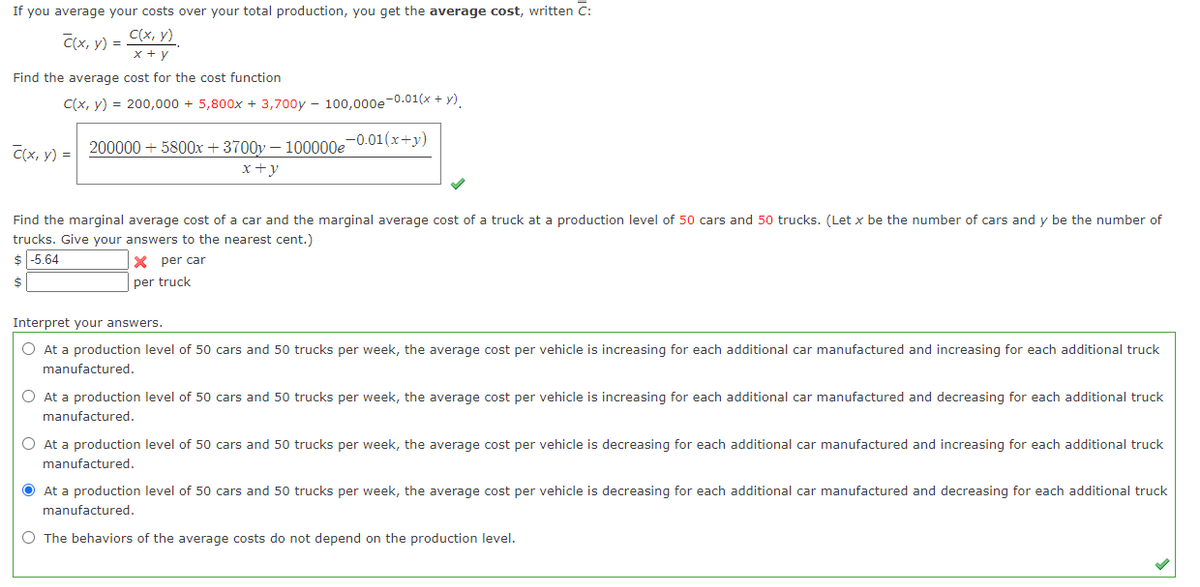If you average your costs over your total production, you get the average cost, written C: C(x, y) = C(x, y) x + y Find the average cost for the cost function C(x, y) = 200,000 + 5,800x + 3,700y – 100,000e¬0.01(x + y). C(x, y) = 200000 + 5800x +3700y – 100000e-0.01(x+y) x+y Find the marginal average cost of a car and the marginal average cost of a truck at a production level of 50 cars and 50 trucks. (Let x be the number of cars and y be the number of trucks. Give your answers to the nearest cent.) $ -5.64 X per car per truck Interpret your answers. O At a production level of 50 cars and 50 trucks per week, the average cost per vehicle is increasing for each additional car manufactured and increasing for each additional truck manufactured. O At a production level of 50 cars and 50 trucks per week, the average cost per vehicle is increasing for each additional car manufactured and decreasing for each additional truck manufactured. O At a production level of 50 cars and 50 trucks per week, the average cost per vehicle is decreasing for each additional car manufactured and increasing for each additional truck manufactured. At a production level of 50 cars and 50 trucks per week, the average cost per vehicle is decreasing for each additional car manufactured and decreasing for each additional truck manufactured. O The behaviors of the average costs do not depend on the production level.
If you average your costs over your total production, you get the average cost, written C: C(x, y) = C(x, y) x + y Find the average cost for the cost function C(x, y) = 200,000 + 5,800x + 3,700y – 100,000e¬0.01(x + y). C(x, y) = 200000 + 5800x +3700y – 100000e-0.01(x+y) x+y Find the marginal average cost of a car and the marginal average cost of a truck at a production level of 50 cars and 50 trucks. (Let x be the number of cars and y be the number of trucks. Give your answers to the nearest cent.) $ -5.64 X per car per truck Interpret your answers. O At a production level of 50 cars and 50 trucks per week, the average cost per vehicle is increasing for each additional car manufactured and increasing for each additional truck manufactured. O At a production level of 50 cars and 50 trucks per week, the average cost per vehicle is increasing for each additional car manufactured and decreasing for each additional truck manufactured. O At a production level of 50 cars and 50 trucks per week, the average cost per vehicle is decreasing for each additional car manufactured and increasing for each additional truck manufactured. At a production level of 50 cars and 50 trucks per week, the average cost per vehicle is decreasing for each additional car manufactured and decreasing for each additional truck manufactured. O The behaviors of the average costs do not depend on the production level.
Algebra and Trigonometry (MindTap Course List)
4th Edition
ISBN:9781305071742
Author:James Stewart, Lothar Redlin, Saleem Watson
Publisher:James Stewart, Lothar Redlin, Saleem Watson
Chapter2: Functions
Section2.4: Average Rate Of Change Of A Function
Problem 4.2E: bThe average rate of change of the linear function f(x)=3x+5 between any two points is ________.
Related questions
Question
Last person got the answer wrong so I will try again with more details I suppose.
This whole answer has to deal with partial derivatives
I am looking for the average cost
Do I find the marginal average cost by finding the partial derivatives of the average cost function? And if so, how would one do that? Any help would be appreciated.

Transcribed Image Text:If you average your costs over your total production, you get the average cost, written C:
C(x, y) =
C(x, y)
x + y
Find the average cost for the cost function
C(x, y) = 200,000 + 5,800x + 3,700y - 100,000e-0.01(x + y)
C(x, y) =
200000 + 5800x + 3700y – 100000e
-0.01(x+y)
x+y
Find the marginal average cost of a car and the marginal average cost of a truck at a production level of 50 cars and 50 trucks. (Let x be the number of cars and y be the number of
trucks. Give your answers to the nearest cent.)
$ -5.64
X per car
2$
per truck
Interpret your answers.
O At a production level of 50 cars and 50 trucks per week, the average cost per vehicle is increasing for each additional car manufactured and increasing for each additional truck
manufactured.
O At a production level of 50 cars and 50 trucks per week, the average cost per vehicle is increasing for each additional car manufactured and decreasing for each additional truck
manufactured.
O At a production level of 50 cars and 50 trucks per week, the average cost per vehicle is decreasing for each additional car manufactured and increasing for each additional truck
manufactured.
O At a production level of 50 cars and 50o trucks per week, the average cost per vehicle is decreasing for each additional car manufactured and decreasing for each additional truck
manufactured.
O The behaviors of the average costs do not depend on the production level.
Expert Solution
This question has been solved!
Explore an expertly crafted, step-by-step solution for a thorough understanding of key concepts.
This is a popular solution!
Trending now
This is a popular solution!
Step by step
Solved in 4 steps

Knowledge Booster
Learn more about
Need a deep-dive on the concept behind this application? Look no further. Learn more about this topic, geometry and related others by exploring similar questions and additional content below.Recommended textbooks for you

Algebra and Trigonometry (MindTap Course List)
Algebra
ISBN:
9781305071742
Author:
James Stewart, Lothar Redlin, Saleem Watson
Publisher:
Cengage Learning

Algebra and Trigonometry (MindTap Course List)
Algebra
ISBN:
9781305071742
Author:
James Stewart, Lothar Redlin, Saleem Watson
Publisher:
Cengage Learning